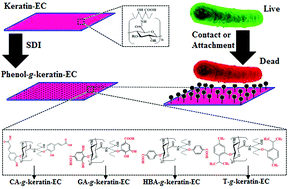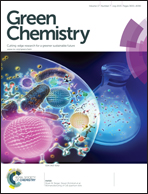In situ development of self-defensive antibacterial biomaterials: phenol-g-keratin-EC based bio-composites with characteristics for biomedical applications†
Abstract
Recently, the development of highly inspired biomaterials with multi-functional characteristics has gained considerable attention, especially in biomedical and other health-related areas of the modern world. It is well known that the lack of antibacterial potential has significantly limited biomaterials for many challenging applications such as infection-free wound healing and/or tissue engineering. In this perspective, a series of novel bio-composites with natural phenols as functional entities and keratin-EC as a base material were synthesised by laccase-assisted grafting. Subsequently, the resulting composites were removed from their respective casting surfaces and critically evaluated for their antibacterial and biocompatibility features. Information is also given on their degradation profile in soil. In situ synthesised phenol-g-keratin-EC bio-composites possess strong anti-bacterial activity against the Gram-positive and Gram-negative bacterial strains, i.e., B. subtilis NCTC 3610, S. aureus NCTC 6571, E. coli NTCT 10418 and P. aeruginosa NCTC 10662. More specifically, 10HBA-g-keratin-EC and 20T-g-keratin-EC composites were 100% resistant to colonisation by all of the aforementioned bacterial strains, whereas 15CA-g-keratin-EC and 15GA-g-keratin-EC showed almost negligible colonisation. Moreover, at various phenolic concentrations, it was clear that the newly synthesised composites remained cytocompatible with human keratinocyte-like HaCaT, as an obvious cell ingrowth tendency was observed during the neutral red dye uptake assay. From the degradation point of view, an increase in the degradation rate was recorded during the soil burial analyses. Our investigations could encourage greater utilisation of natural materials in the development of bio-composites with novel and sophisticated characteristics for potential applications.


 Please wait while we load your content...
Please wait while we load your content...